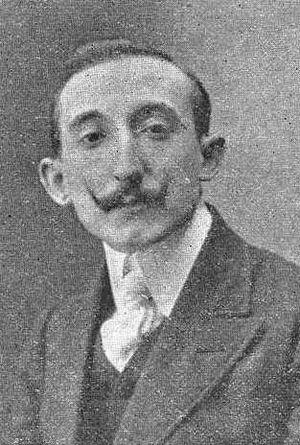Wenceslao Fernández Flórez facts for kids
Quick facts for kids
The Most Excellent
Wenceslao Fernández Flórez
|
|
|---|---|
 |
|
| Born |
Wenceslao Fernández Flórez
1885 A Coruña, Spain
|
| Died | 29 April 1964 (aged 78–79) Madrid, Spain
|
| Seat S of the Real Academia Española | |
| In office 14 May 1945 – 29 April 1964 |
|
| Preceded by | José Alemany y Bolufer |
| Succeeded by | Julián Marías |
Wenceslao Fernández Flórez (born in 1885 in A Coruña, Galicia, and died on April 29, 1964, in Madrid) was a well-known Spanish journalist and writer. He lived in the early 1900s. Wenceslao was from Galicia, a region in Spain, and he always loved his home region very much. He wrote many popular books and articles.
Contents
Becoming a Writer and Journalist
Wenceslao's father passed away when Wenceslao was only fifteen years old. This meant he had to stop going to school. He started working as a journalist to help his family.
First Jobs in Journalism
His very first job was at a newspaper called La Mañana in A Coruña. After that, he wrote for other newspapers like El Heraldo de Galicia, Diario de A Coruña, and Tierra Gallega. When he was just eighteen, he got an important job at Diario Ferrolano. Later, he went back to A Coruña to work at El Noroeste.
Friends and Influences
Wenceslao was good friends with many important people in Galicia. These friends included leaders and thinkers who were interested in Galician culture. Some of his friends were older than him, like Manuel Maria Puga y Parga (also known as Picadillo), the Carré brothers, Tettamanci, Manuel Casas, and Angel Castillo. One person who really shaped his ideas was Castelao. Castelao was an artist who often drew pictures for Wenceslao's books.
Joining the Royal Spanish Academy
Wenceslao Fernández Flórez was chosen to be a member of the Real Academia Española. This is a very important group that looks after the Spanish language. He officially joined the Academy on May 14, 1945. He held his special seat, called "Seat S," until he passed away.
Moving to Madrid and Writing Books
In 1914, Wenceslao moved to Madrid, the capital city of Spain. There, he continued his work as a journalist.
Newspaper Work in Madrid
He worked for big newspapers like El Imparcial and Diario ABC. At Diario ABC, he started a special column called Acotaciones de un oyente. This column was about what happened in the Spanish parliament.
His First Novels
While working as a journalist, Wenceslao also began writing novels. Some of his early books include La tristeza de la paz (which means The Sadness of Peace) in 1910. He also wrote La procesión de los días (The Procession of Days) and Luz de luna (Moonlight), both published in 1915. Another early novel was Volvoreta in 1917.
Books Translated into English
One of his books, The Seven Pillars, was translated into English. Sir Peter Chalmers Mitchell translated it, and it was published in London in 1934.
List of His Works
Wenceslao Fernández Flórez wrote many books and collections of stories. Here are some of his most famous works:
- The sadness of Peace (1910)
- The procession of Days (1914)
- Moonlighting (1915)
- Dimensioning of a listener (Parliamentary Chronicles, 1916)
- Volvoreta (1917) – This book was later made into a movie in 1976.
- The Devil's Eye (1918)
- Entered a Thief (1922)
- Vulgar tragedies of life (1922) – This is a collection of short stories.
- Bluebeard's Secret (1923)
- Visions of neurasthenia (1924)
- Women's Footsteps (1924)
- The seven columns (1926)
- Immoral Story (1927)
- The man who wanted to kill (1929) – This book was made into movies twice, in 1942 and 1970.
- Artificial Ghosts (1930) – Another collection of short stories.
- Those who did not go to war (1930)
- The evil Carabel (1931) – This book was made into movies three times.
- The man who bought a car (1932)
- Knight Adventures Rogelio Amaral (1933)
- An island in the Red Sea (1938)
- The novel number 13 (1941)
- The Living Forest (1943) – This book was made into movies several times, including in 1945, 1987, and 2001.
- The bull, the bullfighter and the Cat (1946)
- Pelegrin system (1949)
- Fireworks (1954)
- Goalkeeper in goal (1957)
Images for kids
See also
 In Spanish: Wenceslao Fernández Flórez para niños
In Spanish: Wenceslao Fernández Flórez para niños


